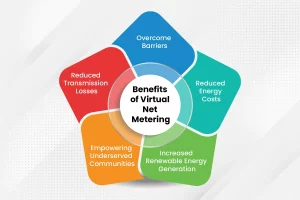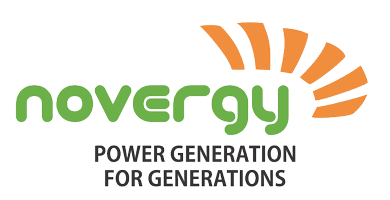Introduction to Net Metering
Industries are always looking for new ways to save more, whether it’s money or resources, and many of them have switched from electrical energy to solar energy. Now, most industries have been opting for solar energy. Manufacturers are introducing new products like Net Metering to help industries save more.
Net Metering helps industries to save more by reversing the process of energy usage. It is a system where your electricity meter can run in reverse when your renewable energy source produces more power than you consume, effectively giving you a credit on your future electricity bills.
But when you want to apply a Net metering system, the question that comes to your mind is which one to choose? Virtual net metering or group net metering.
In this blog, we will talk about how net metering works, what its pros and cons are, and which one suits you the best.
Defining Virtual Net Metering
Virtual net metering enables multiple individuals to utilize solar power systems, even if they don’t have solar panels on their property.
It’s an upgraded version of traditional net metering where the electricity generated by a shared system is credited to individual accounts based on their efficiency.
This helps businesses with less space for individual installations to access solar energy.
How a Virtual Metering System Works
- Shared Solar System: A single solar system generates energy for multiple individuals and feeds it into the grid.
- Grid Credits: The billing credit is distributed according to the utilization of energy among the users.
- Shared Benefits: Each participant’s share of the solar output is credited to their utility account, reducing their electricity bills.
- No Physical Installation Needed: Participants do not need to own or install any solar panels on their properties to benefit from the system.
- Billing System: As every individual gets a share of their usage, software is allocated to help them receive their solar credits.
Defining Group Net Metering
Group Net Metering allows an individual with multiple service connections to share solar energy credits generated at one location across all their connected properties within the same distribution licensee area.
Extra solar power from one location can reduce electricity bills at other places owned by the same person.
Eligible Participants for Group Net Metering
People with multiple properties or services are the only ones who can use this system. Group Net Metering is only eligible for users with multiple electricity accounts within the same distribution company area.
How Virtual and Group Net Metering Work
Metering Infrastructure and Setup
Virtual and group net metering rely on a combination of digital billing systems and advanced metering infrastructure.
These setups include solar panels installed at a primary site, smart meters to measure electricity generation and usage, and software that connects this data to the utility’s billing system.
Extra solar power produced at one location can be tracked and then used to lower the electricity bills at other properties owned by the same person or organization.
This digital setup ensures energy credits are accurately measured and distributed across all linked accounts.
Energy Allocation Across Multiple Accounts
The energy generated is distributed to multiple accounts of the same owner, as it is in multiple properties of an individual in group Net metering.
The energy created in virtual net metering is divided across the individual accounts of all users who have agreed to split the energy bill based on consumption.
Billing Adjustments and Credits
The bills and credits are divided according to the consumption of the individual or the property. If an individual is consuming more energy than other users, then that person has to pay more, as it is counted in the AMI.

Benefits and Challenges of Virtual Net Metering
Though virtual and group net metering have many common traits, they have several different benefits as well:
Benefits of Virtual Net Metering
- Overcome Barriers: VNM makes it easy for many people to use solar energy without having solar panels on their roof.
- Reduced Energy Costs: Participants in Virtual Net Metering (VNM) programs earn credits on their electricity bills based on their portion of energy produced by a shared renewable energy system, helping reduce their overall energy costs.
- Increased Renewable Energy Generation: VNM helps multiple consumers to participate in renewable energy projects by increasing their overall generation of clean energy.
- Reduced Transmission Losses: Virtual Net Metering (VNM) helps reduce energy losses by generating electricity closer to where it’s used, minimizing the need for long-distance transmission and distribution.
- Empowering Underserved Communities: It plays an important role in providing renewable energy to all communities, regardless of their socioeconomic status and location.
Technological Backbone of Virtual Metering Systems
Smart Meters and Real-Time Data
Virtual Net Metering counts the real-time consumption of an individual so that when it’s time to pay the bills, they get the correct amount.
Energy Management Software
Advanced Metering Infrastructure manages all the data of the energy consumption as energy management software for the community.
Challenges and Limitations
Despite having many advantages, Virtual and Group Net Metering have their own limitations and challenges:
Limitations of Virtual Net Metering
- Grid Stability: High usage of VNM systems can cause instability to grid systems, usually during the time of fluctuating demand and high demand generation.
- Metering Inaccuracies: The measurements taken by AMI can be wrong, leading to credit allocation issues.
- Technical Complexity: Implementing and managing VNM systems can be technically complex, requiring specialized equipment and expertise.

Benefits and Challenges of Group Net Metering
Benefits of Group Net Metering
- Cost Reduction: GNM helps many property owners to utilize the renewable energy of a single energy source across multiple connections, leading to a reduction in the overall consumption cost of electricity.
- Overcoming Space Constraints: GNM allows consumers to leverage available space on one property to benefit multiple locations, even if other properties have limited or no space for solar panels.
- Single Point of Contact: It allows consumers to manage a single, centralized solar power plant, simplifying maintenance and operations.
- Encouraging Renewable Energy: Its policies encourage the adoption of solar power, contributing to the growth of renewable energy sources.
- One Application, Multiple Benefits: GNM simplifies the process of multiple connections by applying only one form for the entire group.
Limitations of Group Net Metering
- Capacity limits: These systems are allowed but must stay within certain capacity limits—specifically, they can be up to five times the sanctioned load of the consumer, with a maximum capacity of 10 megawatts.
- System Design and Maintenance: The maintenance of the GNM system is high and requires coordination among participants, as it is a collectively owned solar system.
- Grid Integration: Integrating GNM systems into the grid can present technical challenges, particularly in areas with high solar penetration.
Conclusion
Virtual and Group Net Metering help make solar energy more accessible and cost-effective. Virtual Net Metering is great for people without suitable rooftops, while Group Net Metering benefits those with multiple properties.
Both systems let users share solar power and save on energy bills. They also support cleaner energy and a smarter grid. As more people switch to solar, these models will play a key role in the future of energy.
Interested in getting started? Contact Novergy Solar to learn more.
FAQs
1. What is the difference between virtual net metering and group net metering?
Virtual net metering allows multiple individuals to use energy from one source, while Group net metering allows a person with multiple properties to use energy from one source for all their properties.
2. What is the AMR in metering?
AMR is a device that is used to collect data on the consumption of electricity per individual.
3. How is meter reading calculated?
They are calculated by subtracting the previous reading from the current reading and then multiplying the difference by the tariff rate to determine the cost.
4. What is the full form of MDAS in meter reading?
Meter data acquisition system is the full form of MDAS in meter reading.
5. What is the difference between HES and MDM?
HES collects data from smart meters and sends it to MDM, which checks, processes, and organizes the data for billing and reporting. HES handles communication; MDM handles analysis and management.

